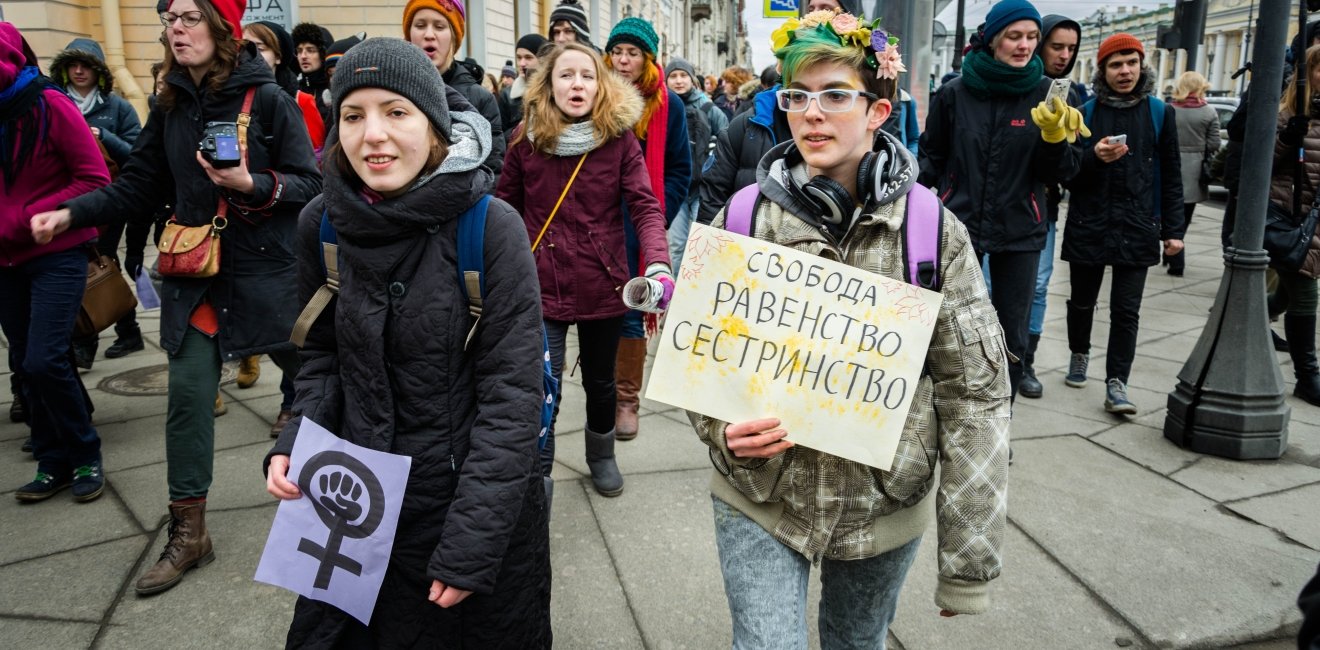
A blog of the Kennan Institute
BY VICTORIA PARDINI
In late 1979, at the height of the Brezhnev era, a small group of radical feminists emerged in the Soviet Union, publishing a critique of gender inequality in the samizdat journal Women and Russia.
The editors—Tatiana Mamonova, Tatiana Goricheva, Natalia Malakhovskaya, and Julia Voznesenskaya—addressed issues relating to the double burden women carried between raising a family while working, maternal health, and the psychological impact of gender inequality. After the first issue of the journal was published in late fall 1979, they were exiled from the Soviet Union. In Europe, they caught the attention of the women’s liberation movement. The attention paid to the women, and in particular to Tatiana Mamonova, who held a view of feminism most similar to that of the West, offers an interesting glimpse into an ideological battle ever present during the Cold War and the agency of a dissident’s narrative once it is introduced to a Western audience.
The journal was the brainchild of Mamonova, who had studied nineteenth-century feminist philosophers, including Anna Filosofova, as well as thinkers from the 1920s, such as the early feminist Alexandra Kollontai and the poet Marina Tsvetaeva. Mamonova’s perspective was further shaped by observing the unequal treatment of women in a nominally equal society in terms of their unique psychological burdens, low wages, and family responsibilities.
The first issue of the journal included poetry, illustrations, and articles criticizing the state of affairs in the Soviet Union for women. In particular, the editors launched an attack on the broader dissident community for its own “feudal conditions,” which persisted even among intellectual families and forced women to act in a more masculine manner, thereby opening a rift in those social circles. The contributors also wrote on the substandard health care for women in the Soviet Union and the pressure of balancing work and motherhood, and challenged the male-dominated dissident community at the time on its resistance to a feminist journal.
The editors were required to appear before the KGB and were formally exiled from the Soviet Union in July 1980. Mamonova continued to work on a second issue of Women and Russia while the remaining women started a religious feminist publication called Mariya, which offered a spiritual perspective on Soviet feminism.
The four women came to the attention of the West when Robin Morgan, an American feminist and activist, interviewed them in Vienna for a Ms. magazine article titled “The First Feminist Exiles from the U.S.S.R.” The cover story focused on the women’s perspective on issues such as pornography and motherhood, but noted that “in the USSR—and in the West, too—a woman is educated in the spirit of hatred against women.” In adopting this tactic, Morgan tried to bring these Soviet feminists into the larger fight against what they viewed as a patriarchal state.
After the Ms. article was published, Mamonova personally was showered with fan mail, with one letter proclaiming, “Now I see the lies they [Soviet Union] would like us to believe [about gender equality].” She became a symbol of the larger social oppression of the Soviet state as viewed through a Western lens.
Mamonova’s Rebranding as Victim
Morgan invited Mamonova to the United States to discuss her experiences in the Soviet Union in October 1980, with support from the Ford Foundation. As part of a speaking tour, Mamonova visited twenty college campuses to discuss the magazine article and what she saw as the plight of Soviet women.
However, as mainstream news outlets began to take up her story, the narrative shifted, and Mamonova began to be cast as an archetypal Soviet victim rather than as an activist in the women’s liberation movement. Some news outlets emphasized the “Orwellian” system she had escaped. Others incorrectly attributed the rise of the new Soviet feminists to the increasing influence of the West, portraying Mamonova and her contemporaries through the lens of victimhood.
Ultimately, the story of late Soviet feminists offers a narrative familiar from US-Soviet rhetoric during the Cold War. Although Mamonova was taken seriously by her contemporaries in the women’s liberation movement, the general media shared her story only to the extent that it could be read as a cautionary tale on the evils of the Soviet system.
This was especially the case when Mamonova and other late-Soviet feminists lost much of their following after the Soviet Union fell. While some continued their activism to a degree, their stories read against a new geopolitical context did not achieve the same sort of traction as had the stories of some of their contemporaries in the dissident movement.
The Usefulness of the Dissident
Mamonova was much more than a useful token victim for the West’s consumption, however. Her philosophy and her work were primarily informed by Soviet Russian feminism rather than by the feminism that emerged following contact with the West. Her views aligned with those of such radical Western feminists as Robin Morgan, but she represented a uniquely Russian and Soviet brand of feminism, and her pen was wielded against the problems specific to that system.
Nonetheless, her story is representative of the broader tokenization of dissidents in the late Soviet period, a pattern that continues today in critiques of Putin and the Kremlin. While there was much to criticize about the Soviet system, the stories of some dissidents were publicized by the West not out of a genuine interest in the agenda of these activists but instrumentally, to showcase the West’s stark opposition to an adversarial government.
This pattern is still in play today. In 2012, the protest performance group Pussy Riot burst into the public consciousness of Western media consumers as a symbol of political repression. However, some argued that the media attention focused on the group detracted from the cause of other, more serious repressions in the country. The narrative promulgated by Western media also simplified Pussy Riot’s agenda, wrapping up the whole experience tidily as yet another example of oppression by the Kremlin rather than considering more deeply the message of the activists on behalf of free speech and human rights.
Mamonova similarly was portrayed in the mainstream media less as a radical activist and thinker and more as a victim of the socialist system because of the forced exile of her and her colleagues. Her story became an easy device with which to take aim at a political system rather than a serious voice advocating for a social cause.
These feminist dissidents represent a moment in time when the United States was seemingly winning the ideological battle against the Soviet Union. Convenient figures of dissent, they were absorbed into the Western narrative of an oppressed socialist people.
The fortieth anniversary of the movement is a helpful reminder of the use of dissidents by the West, and of how foreign governments can use the stories of activists, especially exiled ones, to pursue their own geopolitical aims. We may also pause for a moment to reflect on the social causes these feminist activists fought for and which remain germane today.
The opinions expressed in this article are those solely of the author and do not reflect the views of the Kennan Institute.
Author


Kennan Institute
After more than 50 years as a vital part of the Wilson Center legacy, the Kennan Institute has become an independent think tank. You can find the current website for the Kennan Institute at kennaninstitute.org. Please look for future announcements about partnership activities between the Wilson Center and the Kennan Institute at Wilson Center Press Room. The Kennan Institute is the premier US center for advanced research on Eurasia and the oldest and largest regional program at the Woodrow Wilson International Center for Scholars. The Kennan Institute is committed to improving American understanding of Russia, Ukraine, Central Asia, the South Caucasus, and the surrounding region through research and exchange. Read more

Explore More in The Russia File
Browse The Russia File
Chechnya as a Model of Modern Russia

Russia’s Indigenous Communities and the War in Ukraine

Gas and Power in a Changing US–Russia Relationship

